steering wheel Acura TSX 2004 Owner's Manual
[x] Cancel search | Manufacturer: ACURA, Model Year: 2004, Model line: TSX, Model: Acura TSX 2004Pages: 364, PDF Size: 5.35 MB
Page 8 of 364

This section gives you important
inf ormation about how to protect
yourself and your passengers. It
shows you how to use seat belts
properly. It explains your Supple-
mental Restraint System. And it tells
you how to properly restrain inf ants
andchildreninyourcar..........
Important Safety Precautions . 6
.............
Your Car’s Saf ety Features . 7
.......................................
Seat Belts .8
...........................................
Airbags .9
..................
Seats and Seat-Backs . 10
..........................
Head Restraints .11
..................................
Door Locks .11
........
Pre-Drive Saf ety Checklist . 11
............................
Protecting Adults .12
.....
1. Close and Lock the Doors . 12
...........
2. Adjust the Front Seats . 13 ............
3. Adjust the Seat-Backs . 14
...
4. Adjust the Head Restraints . 15
5. Fasten and Position the Seat .....................................
Belts .15
....
6. Adjust the Steering Wheel . 18
7. Maintain a Proper Sitting ................................
Position .18
.....
Advice f or Pregnant Women . 19
...
Additional Safety Precautions . 20
........................
Protecting Children .21
All Children Must Be ...............................
Restrained .21
Children Should Sit in the Back ...........................................
Seat .22
The Passenger’s Front Airbag Poses Serious Risks to ...............................
Children .22
If You Must Drive with Several ...................................
Children .24
If a Child Requires Close ..................................
Attention .25
...
Additional Safety Precautions . 25
General Guidelines f or Using ...............................
Child Seats .26
.......................
Protecting Inf ants .30
.........
Protecting Small Children . 33 .......
Protecting Larger Children . 36
Using Child Seats with .....................................
Tethers .39
.............................
Using LATCH .41
Additional Inf ormation About Your .................................
Seat Belts .43
..
Seat Belt System Components . 43
......................
Lap/Shoulder Belt .43
Automatic Seat Belt ...............................
Tensioners .44
...............
Seat Belt Maintenance . 45
Additional Inf ormation About ...........................
Your Airbags .46
........................
SRS Components .46
How Your Front Airbags .........................................
Work .46
...
How Your Side Airbags Work . 48
How Your Side Curtain ..........................
Airbags Work .49
..
How the SRS Indicator Works . 49
How the Side Airbag Cutof f ...........
Indicator Light Works . 50
.............................
Airbag Service .51
...
Additional Safety Precautions . 52
.............
Carbon Monoxide Hazard . 53
...................................
Saf ety Labels .54
Driver and Passenger Saf ety
Driver and Passenger Saf ety
5
Page 13 of 364
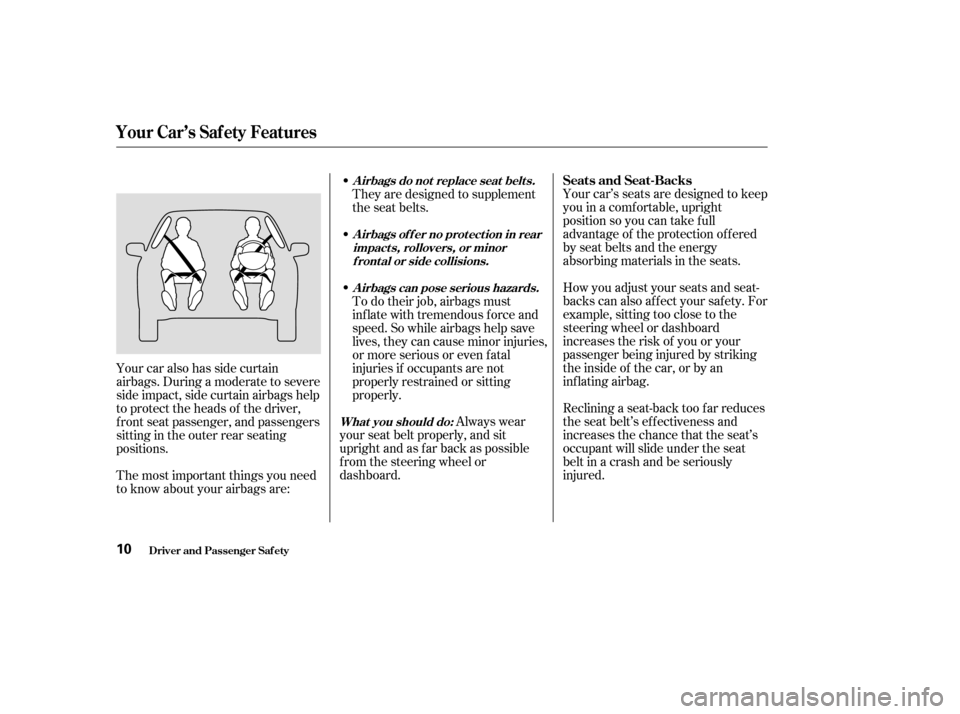
Your car’s seats are designed to keep
you in a comf ortable, upright
position so you can take f ull
advantage of the protection offered
by seat belts and the energy
absorbing materials in the seats.
How you adjust your seats and seat-
backs can also affect your safety. For
example, sitting too close to the
steering wheel or dashboard
increases the risk of you or your
passenger being injured by striking
theinsideof thecar,orbyan
inf lating airbag.
Reclining a seat-back too f ar reduces
the seat belt’s ef f ectiveness and
increases the chance that the seat’s
occupant will slide under the seat
belt in a crash and be seriously
injured.
Always wear
your seat belt properly, and sit
upright and as f ar back as possible
f rom the steering wheel or
dashboard. They are designed to supplement
the seat belts.
To do their job, airbags must
inf late with tremendous f orce and
speed. So while airbags help save
lives, they can cause minor injuries,
or more serious or even fatal
injuries if occupants are not
properly restrained or sitting
properly.
Your car also has side curtain
airbags. During a moderate to severe
side impact, side curtain airbags help
to protect the heads of the driver,
f ront seat passenger, and passengers
sitting in the outer rear seating
positions.
The most important things you need
to know about your airbags are:
Driver and Passenger Saf ety
Your Car’s Saf ety Features
Seats and Seat-Backs
What you should do:
A irbags of f er no prot ect ion in rear
impact s, rollovers, or minorf ront al or side collisions.
Airbags do not replace seat belts.
Airbags can pose serious hazards.
10
Page 14 of 364

Frontseatoccupantsaresitting
upright and as f ar back as possible
f rom the steering wheel and
dashboard (see page ).
Seat-backs are upright (see page).
Head restraints are properly
adjusted (see page ).
All doors are closed and locked
(see page ).
All cargo is properly stored or
secured (see page ).
To make sure you and your
passengers get the maximum
protection f rom your car’s saf ety
f eatures, check the f ollowing each
time before you drive away:
All adults, and children who have
outgrown child saf ety seats, are
wearing their seat belts and
wearingthemproperly(seepage ).
Any inf ant or small child is
properly restrained in a child seat
inthebackseat(seepage ).
Move the f ront
seats as far back as possible, and
keep adjustable seat-backs in an
upright position whenever the car is
moving.
Head restraints can help protect you
f rom whiplash and other injuries. For
maximum protection, the back of
your head should rest against the
center of the head restraint.
Keeping your doors locked reduces
thechanceof beingthrownoutof
the car during a crash. It also helps
prevent occupants f rom accidentally
opening a door and f alling out, and
outsiders f rom unexpectedly opening
your doors. 15
14
15
12
21 13
193
Driver and Passenger Saf ety
Your Car’s Saf ety Features
Pre-Drive Saf ety Checklist
Head Restraints
Door L ocksWhat you should do:
11
Page 16 of 364
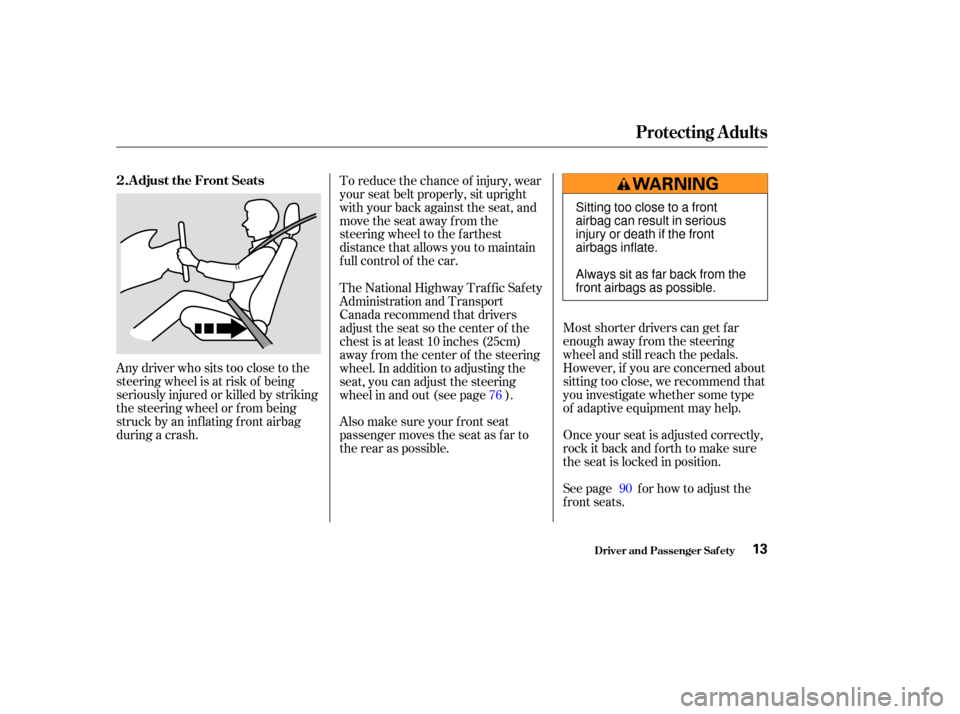
Any driver who sits too close to the
steering wheel is at risk of being
seriously injured or killed by striking
the steering wheel or f rom being
struck by an inflating front airbag
during a crash.To reduce the chance of injury, wear
your seat belt properly, sit upright
with your back against the seat, and
movetheseatawayfromthe
steering wheel to the f arthest
distance that allows you to maintain
f ull control of the car.
Most shorter drivers can get f ar
enough away f rom the steering
wheel and still reach the pedals.
However, if you are concerned about
sitting too close, we recommend that
you investigate whether some type
of adaptive equipment may help.
Once your seat is adjusted correctly,
rock it back and f orth to make sure
the seat is locked in position.
See page f or how to adjust the
f ront seats.
Also make sure your f ront seat
passenger moves the seat as f ar to
the rear as possible. The National Highway Traffic Safety
Administration and Transport
Canada recommend that drivers
adjust the seat so the center of the
chest is at least 10 inches (25cm)
away f rom the center of the steering
wheel. In addition to adjusting the
seat, you can adjust the steering
wheel in and out (see page ).
76
90
Protecting Adults
Adjust the Front Seats
2.
Driver and Passenger Saf ety13
Sitting too close to a front
airbag can result in serious
injury or death if the front
airbags inflate.
Always sit as far back from the
front airbags as possible.
Page 17 of 364
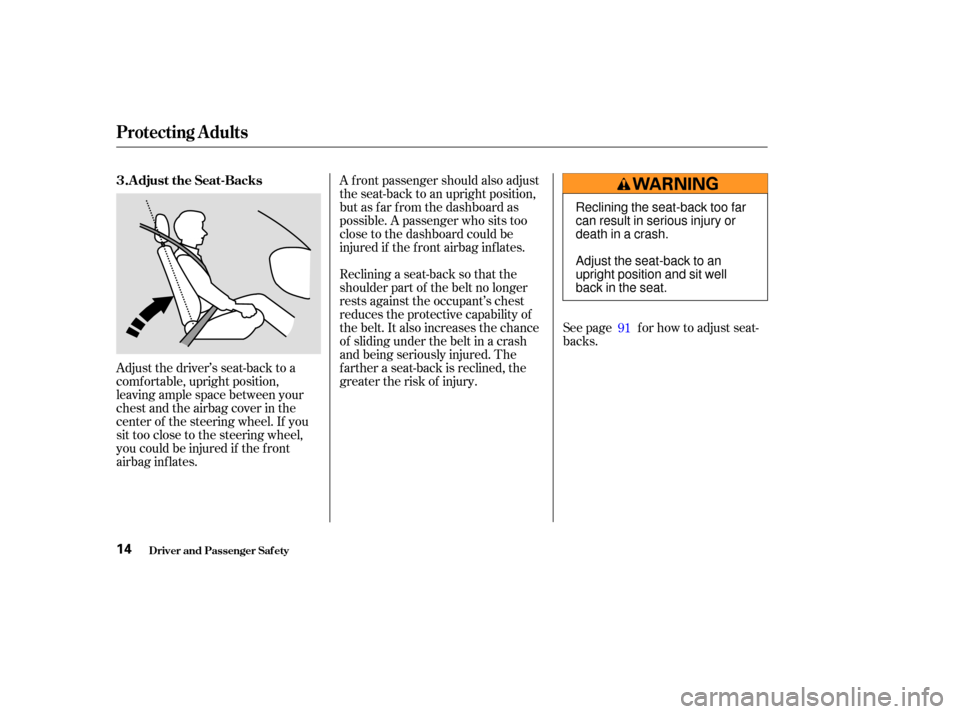
A f ront passenger should also adjust
the seat-back to an upright position,
but as f ar f rom the dashboard as
possible. A passenger who sits too
close to the dashboard could be
injured if the f ront airbag inf lates.
Reclining a seat-back so that the
shoulder part of the belt no longer
rests against the occupant’s chest
reduces the protective capability of
the belt. It also increases the chance
of sliding under the belt in a crash
and being seriously injured. The
farther a seat-back is reclined, the
greater the risk of injury.See page f or how to adjust seat-
backs.
Adjust the driver’s seat-back to a
comf ortable, upright position,
leaving ample space between your
chest and the airbag cover in the
center of the steering wheel. If you
sit too close to the steering wheel,
you could be injured if the f ront
airbag inflates. 91
Protecting Adults
Driver and Passenger Saf ety
Adjust the Seat-Backs
3.
14
Reclining the seat-back too far
can result in serious injury or
death in a crash.
Adjust the seat-back to an
upright position and sit well
back in the seat.
Page 21 of 364
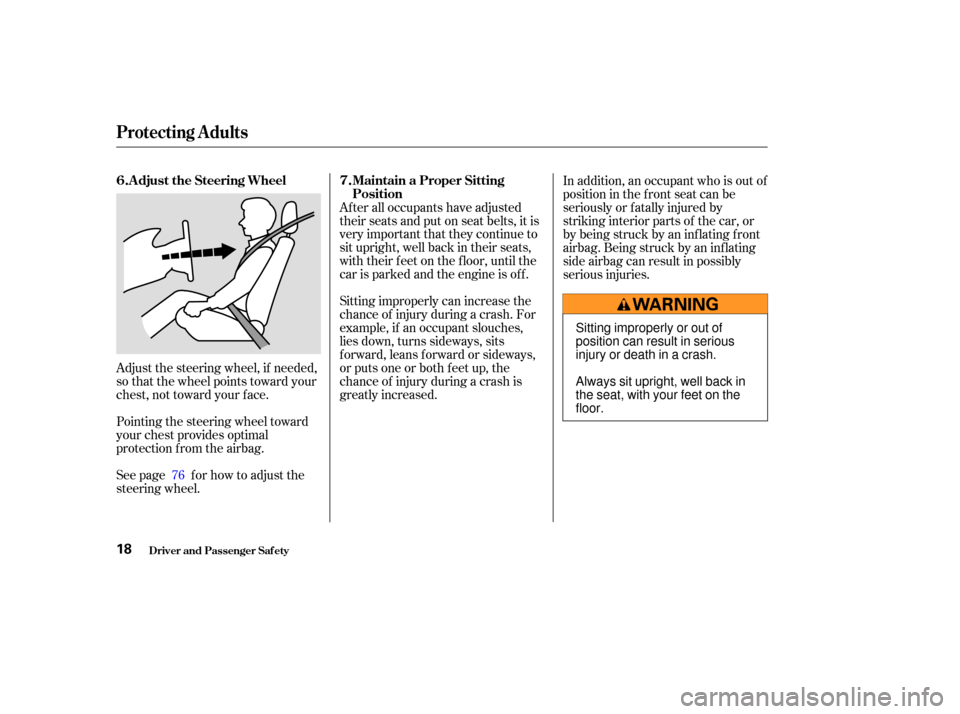
Adjust the steering wheel, if needed,
so that the wheel points toward your
chest, not toward your f ace.
Pointing the steering wheel toward
your chest provides optimal
protection f rom the airbag.
See page f or how to adjust the
steering wheel.After all occupants have adjusted
their seats and put on seat belts, it is
very important that they continue to
sit upright, well back in their seats,
with their feet on the floor, until the
car is parked and the engine is of f .
Sitting improperly can increase the
chance of injury during a crash. For
example, if an occupant slouches,
lies down, turns sideways, sits
forward, leans forward or sideways,
or puts one or both f eet up, the
chance of injury during a crash is
greatly increased.
In addition, an occupant who is out of
position in the f ront seat can be
seriously or f atally injured by
striking interior parts of the car, or
by being struck by an inf lating f ront
airbag. Being struck by an inflating
side airbag can result in possibly
serious injuries.
76
Driver and Passenger Saf ety
Protecting Adults
Adjust the Steering Wheel Maintain a Proper Sitting
Position
6.
7.
18
Sitting improperly or out of
position can result in serious
injury or death in a crash.
Always sit upright, well back in
the seat, with your feet on the
floor.
Page 22 of 364
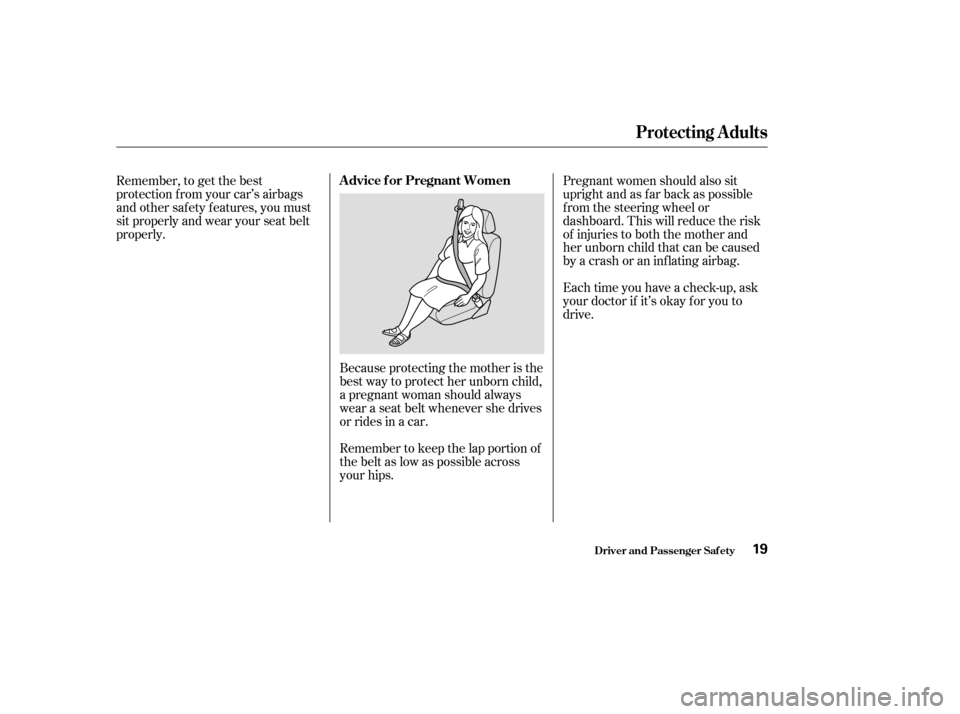
Each time you have a check-up, ask
your doctor if it’s okay f or you to
drive.
Remember to keep the lap portion of
the belt as low as possible across
your hips. Pregnant women should also sit
upright and as f ar back as possible
f rom the steering wheel or
dashboard. This will reduce the risk
of injuries to both the mother and
her unborn child that can be caused
by a crash or an inf lating airbag.
Remember, to get the best
protection f rom your car’s airbags
and other safety features, you must
sit properly and wear your seat belt
properly.
Because protecting the mother is the
best way to protect her unborn child,
a pregnant woman should always
wear a seat belt whenever she drives
or rides in a car.
Protecting Adults
Advice f or Pregnant Women
Driver and Passenger Saf ety19
Page 23 of 364

If they do, they
could be very seriously injured in a
crash.
Devices intended to improve
occupant comf ort or reposition the
shoulder part of a seat belt can
severely compromise the
protective capability of the seat
belt and increase the chance of
serious injury in a crash. Carrying hard or sharp
objects on your lap, or driving with
a pipe or other sharp objects in
your mouth, can result in injuries
if your f ront airbag inf lates.
Any object
attached to or placed on the covers
marked ‘‘SRS AIRBAG’’ in the
center of the steering wheel and
on top of the dashboard could
interf ere with the proper operation
of the airbags. Or, if the airbags
inf late, the objects could be
propelled inside the car and hurt
someone. If a side airbag or a side
curtain airbag inf lates, a cup
holder or other hard object
attached on or near the door could
be propelled inside the car and
hurt someone.
If your
hands or arms are close to the
airbag cover in the center of the
steering wheel or on top of the
dashboard, they could be injured if
the front airbag inflates.
Protecting Adults
Driver and Passenger Saf ety
Additional Saf ety Precautions
T wo people should never use t he
same seat belt .
Do not put any accessories on seatbelts. Do not place hard or sharp object s
bet ween yourself and a f rontairbag.
Do not at t ach or place object s onthe f ront airbag covers. On models wit h side airbags or
side curtain airbags, do not attachhard object s on or near a f rontdoor.
K eep your hands and arms awayf rom t he airbag covers.
20
Page 49 of 364
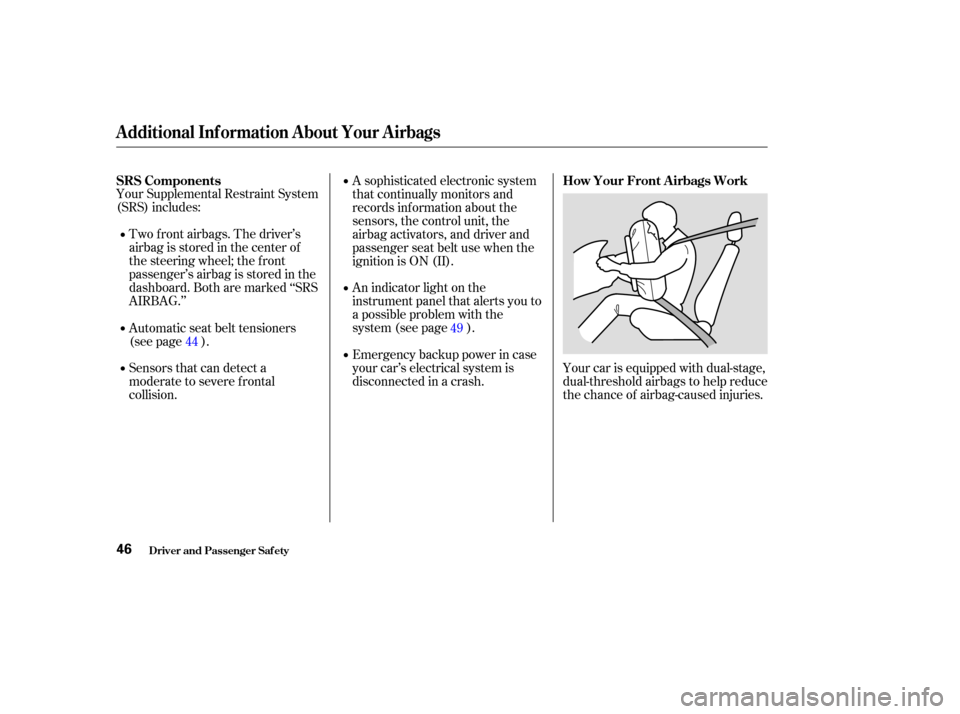
Your Supplemental Restraint System
(SRS) includes:Two f ront airbags. The driver’s
airbag is stored in the center of
the steering wheel; the f ront
passenger’sairbagisstoredinthe
dashboard. Both are marked ‘‘SRS
AIRBAG.’’
Emergency backup power in case
your car’s electrical system is
disconnected in a crash. An indicator light on the
instrument panel that alerts you to
a possible problem with the
system (see page ). A sophisticated electronic system
that continually monitors and
records inf ormation about the
sensors, the control unit, the
airbag activators, and driver and
passenger seat belt use when the
ignition is ON (II).
Your car is equipped with dual-stage,
dual-threshold airbags to help reduce
the chance of airbag-caused injuries.
Automatic seat belt tensioners
(see page ).
Sensors that can detect a
moderate to severe frontal
collision.
44
49
SRS Components
How Your Front A irbags Work
Additional Inf ormation About Your Airbags
Driver and Passenger Saf ety46
Page 60 of 364

This section gives inf ormation about
the controls and displays that
contribute to the daily operation of
your Acura. All the essential controls
are within easy reach............................
Control Locations .58
...............................
Indicator Lights .59
.............................................
Gauges .65
...............................
Speedometer .65
.................................
Tachometer .65
.....................................
Odometer .65
Outside Temperature ...................................
Indicator .66
...................................
Trip Meter .66 ...................
Temperature Gauge . 66
..................................
Fuel Gauge .67
Maintenance Required ...................................
Indicator .67
Controls Near the Steering .......................................
Wheel .69
...................................
Headlights .70
Automatic Lighting Off .....................................
Feature .71
............
Daytime Running Lights . 72
....
Instrument Panel Brightness . 72
................................
Turn Signals .73
.....................
Windshield Wipers .73
..................
Windshield Washers . 75
..........................
Hazard Warning .75
.............
Rear Window Def ogger . 75
......
Steering Wheel Adjustment . 76
...............................
Keys and Locks .77
..............................................
Keys .77
....................
Immobilizer System . 79
............................
Ignition Switch .80
......................
Power Door Locks .81
...................
Remote Transmitter . 83
..............
Childproof Door Locks . 87
...........................................
Trunk .87
........
Emergency Trunk Opener . 88....................................
Glove Box .89
............................
Seat Adjustments .90
Driver’s Seat Full Power ............................
Adjustments .90
...........
Driver’s Lumbar Support . 91
Front Passenger’s Seat ............................
Adjustments .92
..........................
Head Restraints .93
.......................
Folding Rear Seat .94
......................
Rear Seat Armrest .95
....................................
Seat Heaters .96
..............................
Power Windows .97
.......................................
Moonroof .101
...........................................
Mirrors .102
..
Adjusting the Power Mirrors . 102
...............................
Parking Brake .104
.................
Console Compartment . 105
..........................................
Armrest .105
.........................
Beverage Holders .106
.........................
Center CD Pocket .107
.................................
Utility Pocket .107
........................................
Sun Visor .108
................................
Vanity Mirror .108
........................
Sunglasses Holder .109
............
Accessory Power Sockets . 109
...............................
Interior Lights .110
Instruments and Controls
Inst rument s and Cont rols57